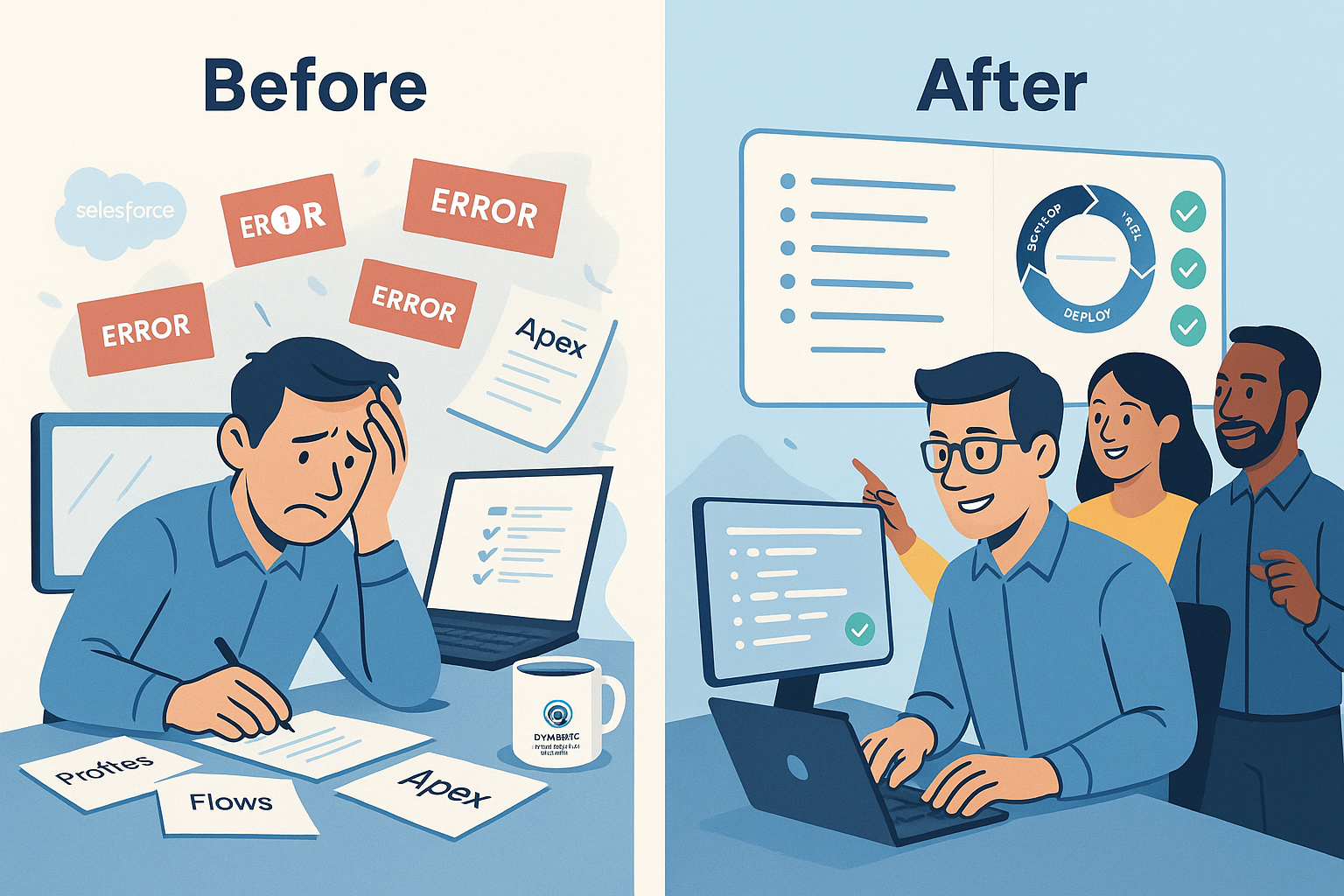Start with Clear, Consistent Communication
Rolling out Salesforce? It’s a big step—and strong communication can make or break it. When everyone understands the goals, changes, and what to expect, you get way fewer surprises and way more alignment.
Keep the updates flowing. Regular check-ins, team updates, and clear documentation help flag potential issues early. And when people know they can speak up, it builds trust and keeps everyone rowing in the same direction.
Pro tip: Tailor how you communicate with your team. Some folks like visuals, others want details, and some just want the short summary. Staying flexible here goes a long way.
Understanding the Deployment Process
Salesforce isn’t just plug-and-play—it’s a system with lots of moving parts. Understanding how things like objects, automation, and layouts interact will save you headaches down the road.
Know What You're Working With
One of the key tools is change sets—great for moving customizations like objects and workflows between Salesforce environments. They’re ideal for smaller, declarative changes. For more complex changes, Salesforce offers better tooling (more on that soon).
Validation is another must. Before pushing changes live, always test everything in a sandbox—think of it as your safety net where you can catch bugs before they reach your users.
And please document everything. Track what’s been changed, when, and why. Future-you (and your team) will thank you—it saves time troubleshooting later and keeps everyone on the same page.
Don’t Ignore Dependencies—Everything’s Connected
Salesforce components are deeply interconnected. A custom field might feed into a formula, a workflow, or even a critical report. Miss one dependency, and things can break.
That’s why dependency mapping and impact analysis are invaluable. Tools like Copado Essentials Plus (what DSG uses), Gearset, or OwnBackup can help you visualize relationships and avoid surprises.
Pro Tip: Keep your team informed about dependencies as you go. It smooths out the whole deployment plan.
Best Practices That Make Deployment Smoother
Embrace Version Control (Git for the Win!)
Whether you’re using Salesforce DevOps Center, GitHub, or Bitbucket, version control is your deployment diary. Track changes, work in branches, and roll back when needed.
If you’re new to Git, start simple: one branch per feature or fix. Once tested, merge it into the main branch. This alone can prevent so many last-minute messes.
Test in Sandboxes
Never test in production—just don’t. That’s rule #1. Instead, use sandboxes tailored to your development stage, where you can trial your changes in a safe place that mimics your live environment. Some examples of sandboxes for different stages include:
- Developer for early-stage work
- Partial Copy for user testing with real-ish data
- Full Copy for end-to-end pre-production testing
Each type addresses different kinds of issues—and builds confidence for go-live.
Code Coverage = Peace of Mind
Salesforce requires 75% Apex code coverage to deploy to production. Honestly, that’s a good thing, but don’t treat that as a checkbox. Write thoughtful test cases that check for all kinds of scenarios, such as:
- Standard use cases
- Edge cases
- Error handling.
Unit tests are another safety net, and they make future updates way safer and faster.
Lean on the Right Tools
There are a bunch of deployment tools available that automate much of the busy work and cut down on human error.
- Change Sets (built-in, good for basic stuff)
- Salesforce CLI + Metadata API (for devs who love automation)
- Ant Migration Tool (scripted deployments)
- Salesforce DevOps Center (GUI + Git integration—a nice bridge between admin and dev workflows)
And don’t sleep on third-party tools like Gearset, Copado, or AutoRABIT—awesome for large teams or fast-paced deployments. Wherever tool(s) you use, pick what fits your team’s style, and you’ll move faster and smarter.
Advanced Tip: Try Salesforce DX
If you’re managing multiple teams or scaling up, Salesforce DX gives you:
- Scratch orgs: temporary, disposable orgs for testing and dev
- Unlocked packages: modular ways to bundle functionalities for clean, reusable deployments
These tools are designed for modern development workflows and integrate seamlessly into Continuous Integration (CI) or Continuous Deployment (CD) pipelines.
Collaborating with Your Team
Share Release Notes (Early & Often)
When something changes, let people know—and don’t just drop a link. Good release notes break down:
- What changed
- What’s new
- Any actions users need to take
Share them via email, Slack, or wherever your people are.
Don’t Let Emails Get Lost
Sounds simple, but if you’re sending out deployment emails (especially through Marketing Cloud), double-check your SPF, DKIM, and DMARC settings. These ensure your messages are delivered and don’t get flagged as spam. Also, keep your emails easy to scan—no one wants to read a wall of text when they’re in the middle of something. Oh, and bonus points for asking for feedback on your email format—the clearer the message, the better it lands.
Make Feedback Part of the Plan
Want to improve your process? After every major deployment, gather feedback. Ask your team:
- What worked?
- What didn’t?
- What should we change next time?
Use quick surveys, forms, or simply talk to folks 1:1. Then—and this is key—act on it. It shows you’re listening, and when people see their feedback taken seriously, they stay engaged.
Don’t Skip Change Management Training
We’ve covered this in an earlier blog post, Mastering Behavioral Change Techniques for CRM Success, but it’s worth mentioning again: even if the deployment is flawless, it can flop without adoption. So, build in user training to your plan:
- Run live walkthroughs
- Share short “how-to” videos
- Offer cheat sheets or help docs
And don’t forget to communicate why the change matters—when people understand the value, they’re more likely to buy in.
After You Go Live
Monitor Like a Hawk
You’ve deployed—now it’s time to make sure everything’s running smoothly. Use Salesforce tools like Setup Audit Trail, Health Check, and/or Event Monitoring to help you track system behavior and spot issues early. Watch for issues with performance, login behavior, system load, and errors—anything that could indicate a hiccup. And be sure to set up alerts so you’re not blindsided, because catching it early means less firefighting later.
Always Have a Rollback Plan
Here’s the thing: Salesforce doesn’t have a native “undo” button for deployments, and not everything goes as planned. That’s why a rollback plan is essential, meaning you need to know how to revert to a working version and test that plan ahead of time, so it’s not a scramble if you need to use it. You’re rollback plan should include:
- A backup of your metadata
- A Git version you can redeploy
- A step-by-step playbook (including testing procedures)
And keep your team informed in the event you do have to roll back—clear communication during those moments is priceless.
Run Audits and Keep an Audit Trail
Regular audits are yet another safety net, helping to ensure your system remains secure and compliant. Review who has access to what, who made system changes and when, and how system behavior changes over time.
Be sure to document everything. That way, you’ve got a clean audit trail of what happened and why, which is super helpful for troubleshooting, compliance, and planning your next move.
Wrapping It Up
Salesforce deployment is equal parts tech, teamwork, and trust. Whether you’re using Change Sets or diving deep into Salesforce DX and Git, the real secret to success is:
- A clear plan
- The right tools
- Open, proactive communication
Follow these simple guidelines and you can roll out Salesforce like a pro—and set the stage for long-term success.






SHARE